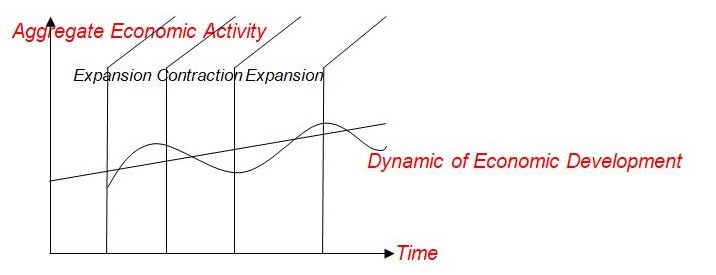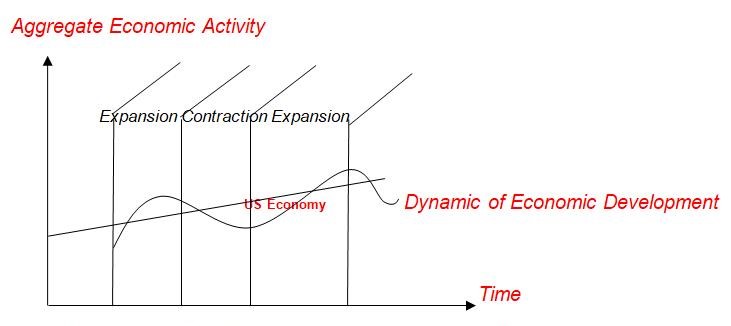Introduction
Economy is a rather complicated network of processes and human activities directed at increasing and preserving the social wellbeing and prosperity. Economy consists of various processes and phenomena that determine the development of the human society and include such notions as currency, inflation, employment, unemployment, Gross Domestic Product (GDP), and business cycle. The development of economy in the business cycle determines its current state and future potential for improvements. Therefore, this paper aims at defining the place of the United States economy in the business cycle at the current stage of its development, finding out the role of GDP growth rates, unemployment, and inflation rates in this place, and considering the implications of all the above factors for the monopolistically competitive firms.
Basic Definitions
Business Cycle
Beginning the discussion of the today of the US economy, it is necessary to define basic terms to be used further. Thus, business cycle is the widest notion used in the paper, and according to MBA (2007), it is the process of fluctuations in economic growth that encompasses of “expansion of above average growth, a peak, a contraction of below average growth, and a trough, or low point” (MBA, 2007). Therefore, the business cycle is the natural process of rises and falls of economic activities conditioned by various internal and external factors, including politics, economic trends inside the country and abroad, etc. The graphic representation of the business cycle can be viewed in the following graph (Graph 1):

Monopolistically Competitive Firms
Competition is the notion used to describe the relations between various market players in a market segment, the balance between the quality and prices for their goods or services, etc. However, Amos (2009) defines monopolistic competition as the state when numerous small firms operate the market with none of them being able to control the dominant market share. Four major factors, according to Amos (2009) characterize monopolistic competition; they include large number of small firms, relative similarity of their products, relative mobility of their resources, and extensive knowledge the buyers have on the firms constituting the monopolistic competition in the market. Thus, a monopolistically competitive firm is one of the many small firms operating in the monopolistic market.
Economic Data
GDP Growth for the recent 6 months
THe current economic situation allows speaking of the monopolistic market in the USA, but the recent economic issues observed around the world demand closer consideration in this respect. Thus, GDP growth levels constitute the major factor to monitor the economic dynamics for a period. Thus, over the first quarter of 2009, the real GDP decreased by 6.4%, while the second quarter saw only 1.0% of decrease. In figures, the GDP for the first quarter of 2009 amounted to $14,178.0 billion, while the second quarter witnesses the decrease to $14,149.8 billion as compared to the peak of GDP growth observed in the second quarter of 2008 when the GDP amounted to $14,497.8 billion (BEA, 2009).
Inflation for the recent 6 months
The inflation rates observed in the USA over the two quarters of 2009 also evidence that the financial and economic issues of global scope affect the US economy and monopolistic market considerably. In February, 2009 the consumer price index of inflation grew by 0.4%, and the following months presented the similarly negative picture of inflation rates growth but with certain hopes for better future (Table 1):
Table 1
Thus, it is obvious that the most critical inflation rate growth level was observed in June 2009, when the growth of inflation amounted to 0.7%. Fluctuations can be observed in the growth levels of inflation that evidence both that the effects of economic stagnation are still observed but also that the country’s economy is recovering from the trough in its development.
Unemployment for the recent 6 months
The situation with (un)employment in the country is also rather problematic as through the two quarters of this year, 2009, the unemployment rate has reported steady growth and only July, 2009 saw the slight decrease of unemployment growth rates. The following graph can illustrate the situation brightly (Graph 2):

Source: BLS. (2009). United States Department of Labor. Retrieved August 25, 2009, from Bureau of Labor Statistics.
Economy in the Business Cycle
Drawing from the GDP, inflation, and unemployment growth rates it is obvious that the US economy is currently at the stage of the business cycle which is called the transition from the trough, or the lowest point of the stagnation possible, to the expansion of the above average growth. The following graph illustrates the position of the US economy at the current stage of its development (Graph 3):

The figures of GDP growth report that crisis is still not overcome but the fact that the steady decrease of growth rates has stopped is the positive sign. Concerning inflation, its growth rates have also recently stopped and allowed the specialists from Amos, BEA, and BLS to hope for the economy recovery. Moreover, the unemployment rates are also currently on the decrease although up to July, 2009 they grew steadily.
Implications for Monopolistically Competitive Firms
The implications of these economic conditions in the country for the monopolistically competitive firms are mainly positive. The economic recession observed in the late 2008 and the first quarter of 2009 is now on the decrease and the US economy recovers now. So, employment rates increase presenting the population with higher income opportunities and respectively with more buying capacities. The decrease of inflation growth rates also allows people to buy more thus increasing the sales rates of the monopolistically competitive firms.
Conclusions
Thus, the current economic conditions in the USA are favorable for the monopolistically competitive firms as recovering from the consequences of the economic recession the country allows these firms to increase their profit through cooperation with the US citizens whose employment opportunities become wider and decreasing inflation growth rates allow them to buy more within their income limits. The US economy is currently at the stage of transition from the trough of the economic crisis to the expansion of above average growth forecasted by specialists.
References
- Amos. (2009). Monopolistic Competition.
- BEA. (2009). National Economic Accounts. Web.
- BLS. (2009). United States Department of Labor. Web.
- MBA. (2007). The Business Cycle. Web.